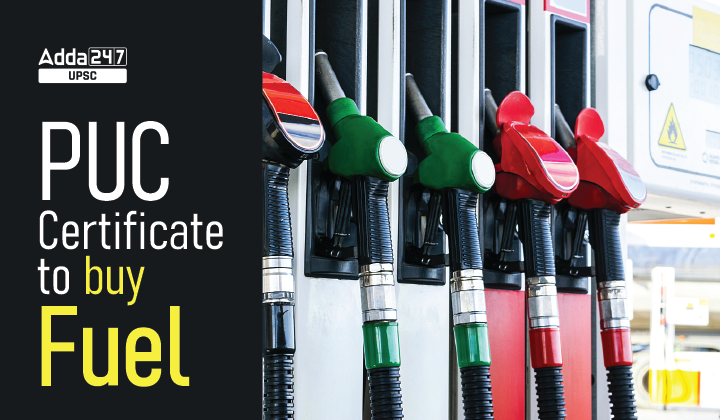Table of Contents
PUC Certificate must to buy fuel in New Delhi: Relevance for UPSC Exam
General Studies III- Conservation, Environmental Pollution & Degradation, EIA
PUC Certificate must to buy fuel in New Delhi: In News
Motorists will not be able to buy fuel in Delhi without a valid Pollution Under Control (PUC) certificate from October 25.
What is PUC Certificate?
- The PUC certificate is a document that any person driving a motor vehicle can be asked to produce by a police officer in uniform authorized by the state government.
- These issue certificates if a vehicle is found complying with the prescribed emission norms.
- Since the Motor Vehicles (Amendment) Act, 2019 came into force, PUC certificate has been made mandatory.
- A PUC certificate contains information such as the vehicle’s license plate number, PUC test reading, date on which the PUC test was conducted and the expiry date.
PUC Certificate: Compliance Rules
- According to Central Motor Vehicles Rules, 1989, every motor vehicle is required to carry a valid PUC Certificate after the expiry of period of one year from the date of its first registration.
- This includes those conforming to BS-I/ BS-II/ BS-III/BS-IV /BS-VI as well as vehicles plying on CNG/LPG.
- However, the validity of four-wheeled BS-IV compliant vehicles is one year and for other vehicles it is three months.
How is a pollution control check carried out?
- The computerized model for pollution check was developed by the Society of Indian Automobile manufacturers.
- A gas analyzer is connected to a computer, to which a camera and a printer are attached.
- The gas analyzer records the emission value and sends it to the computer directly, while the camera captures the license plate of the vehicle.
- Subsequently, a certificate may be issued if the emission values are within the limits.
PUC Certificate: Need
- Emissions from automobiles are major contributors to air pollution all over the world.
- The smoke emitted from vehicles contains the following pollutants:
- Hydrocarbons (HC)
- Carbon Monoxide (CO)
- Oxides of Nitrogen (NOx)
- Particulate Matter (PM)
- Sulphur Dioxide (SO2)
- Carbon Dioxide (CO2)
- Nitrous Oxide (N2O)




 TSPSC Group 1 Question Paper 2024, Downl...
TSPSC Group 1 Question Paper 2024, Downl...
 TSPSC Group 1 Answer key 2024 Out, Downl...
TSPSC Group 1 Answer key 2024 Out, Downl...
 UPSC Prelims 2024 Question Paper, Downlo...
UPSC Prelims 2024 Question Paper, Downlo...





